Advertisement
Master-Realism-1
By Paul W. McCormack
I’ve always taken my artistic inspirations from the expressions of the human form-the ever changing countenance of a friend’s face in conversation, the blank stare of a stranger on a subway, or the poetic gesture of a stance. Although I work in both watercolor and oil (see “The Oil Alternative”),
I began my career nearly 35 years ago by painting the figure in watercolor, a medium that lends itself beautifully to recreating the translucent quality of flesh. By working transparently and using three basic techniques-wet-into wet, glazing and drybrush-I’ve developed a method that gives my portraits a look unlike conventional watercolors. This approach can be very time-consuming: I often spend 80 hours or more painting a simple head and shoulders. But the effort is worth it. The results of this process can prove” quite sublime. Here’s how it works.
Laying the Foundation
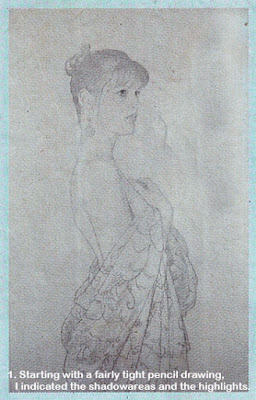 First and foremost, a good portrait should have a timeless quality. It should evoke emotion and reveal the sitter’s personality. And although a good likeness is critical, I also fry to create an aesthetically pleasing piece of art that anyone can appreciate, regardless of whether or not they know the sitter. Because watercolor is an unforgiving medium, I begin my watercolor portraits with a fairly tight line drawing. This drawing usually takes about a day to complete, and includes the shadow planes and the exact placement of the highlights.
First and foremost, a good portrait should have a timeless quality. It should evoke emotion and reveal the sitter’s personality. And although a good likeness is critical, I also fry to create an aesthetically pleasing piece of art that anyone can appreciate, regardless of whether or not they know the sitter. Because watercolor is an unforgiving medium, I begin my watercolor portraits with a fairly tight line drawing. This drawing usually takes about a day to complete, and includes the shadow planes and the exact placement of the highlights.
I primarily use Arches 140-lb. cold-pressed paper and I stretch it before use by soaking it in water for about five minutes, then staple it to a 1/4-inch thick sheet of plywood.
When the paper dries I transfer the drawing to my working surface. Then I’m ready to start laying in color. I always begin with my center of interest-usually the face. All of the other colors are based on my focal point. In this initial stage, I simplify my subject into light, halftone and dark values. I begin each element in my painting in this way, using separate color mixtures and mixing palettes for the flesh, hair, fabrics and backgrounds.
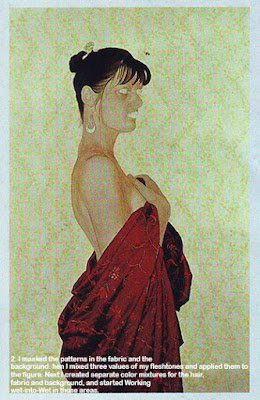 In most of my portraits I use natural light from a north-facing window. North light gives you cool lights and warmer halftones and darks. I start my fleshtones by mixing lights and darks with my standard fleshtone palette of yellow ochre, cerulean blue and rose madder genuine. The opaque and transparent qualities of these particular pigments tend to separate on the paper’s surface, causing a fragmentation-the colors actually separate, leaving spots of warm and cool colors in any given area of the flesh. With the later addition of cadmium red light, I find these colors indispensable when it comes to painting the figure.
In most of my portraits I use natural light from a north-facing window. North light gives you cool lights and warmer halftones and darks. I start my fleshtones by mixing lights and darks with my standard fleshtone palette of yellow ochre, cerulean blue and rose madder genuine. The opaque and transparent qualities of these particular pigments tend to separate on the paper’s surface, causing a fragmentation-the colors actually separate, leaving spots of warm and cool colors in any given area of the flesh. With the later addition of cadmium red light, I find these colors indispensable when it comes to painting the figure.
Next I make a test swatch of these colors on a separate sheet of paper Working wet-into-wet, I apply a large wash of the lightest value, then cover half of that with my halftone mixture. Finally, I cover half of my halftone mixture with my dark mixture. Since I follow the watercolor tradition of working light to dark, I always begin flesh areas two or three values lighter than they are in my actual subject. Since I’ll eventually be working with several layers of glazes, I save this color swatch to use as a testing ground for subsequent washes of color.
Working Wet-Into-Wet
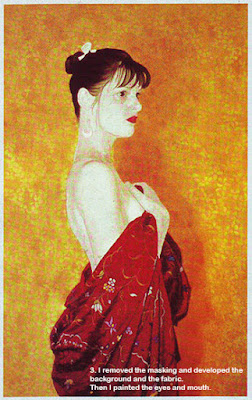 Now I’m ready to apply the first of my three key techniques-wet-into-wet. I use a large round sable brush and clean water to wet all of the flesh areas. I work around the eyes, lips and any highlights that call for hard edges. I then cover the flesh areas with an initial light wash, this time working around any highlights that need soft edges. While this wash is still wet, I lay down my halftone color, followed by my darks. If the surface of the paper begins to dry during this process, I stop working and let it dry completely. Then I re-wet it with clean water and continue.
Now I’m ready to apply the first of my three key techniques-wet-into-wet. I use a large round sable brush and clean water to wet all of the flesh areas. I work around the eyes, lips and any highlights that call for hard edges. I then cover the flesh areas with an initial light wash, this time working around any highlights that need soft edges. While this wash is still wet, I lay down my halftone color, followed by my darks. If the surface of the paper begins to dry during this process, I stop working and let it dry completely. Then I re-wet it with clean water and continue.
When painting wet-into-wet, I find it’s helpful to work as quickly as possible. I lay in my first wash, then leave it alone rather than playing around with it. For more control, I load my brush with color, then pat it on a paper towel. This absorbs a lot of the water and keeps my washes from spreading too much.
Once these initial flesh tones are in place, I use the same approach to apply color to all of the other elements in the painting. But unlike the areas of flesh, I Wash in the other elements at their correct value. This allows me to use these elements as reference points when I bring up color in the face and flesh areas. In this phase, I’m very conscious of my edges. For example, when I’m Working the background color Wet-into-Wet, I drag some of the color into the figure While lifting some of the color, thus creating a soft edge.
After indicating all of my large areas of color, I begin to Work on the features. As I paint the eyes and mouth, I once again pay particular attention to the edges. I paint the eyes Wet-into-Wet to ensure that the iris has a soft look, then use a Wet-onto-dry approach to paint the upper lash, softening the bottom edge into the eye, which creates the illusion that the lid and the lash are coming up and over the eye. Then I move to the mouth using the same approach that I use for flesh, with one important exception-I Wet the mouth well beyond its outer edges to give the lips a soft appear-ance. Finally I use a Warm reddish color to define the line of the eyelid, the nostrils and the separation of the lips. This is important: Using a cool color in these areas deadens the flesh.
Glazing
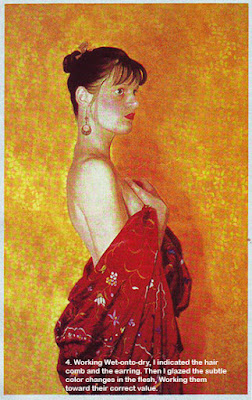 With my Working surface completely covered, I switch to glazing and continue to develop the flesh tones. This essentially means that I’m Working Wet-onto-dry. To make sure my glazes give the look I Want, I test the first color on my initial flesh tone swatch. When I’m certain of the color and value, I load my brush and apply the glaze to the painting. while this is still Wet, I rinse my brush and pat it with a paper towel.
With my Working surface completely covered, I switch to glazing and continue to develop the flesh tones. This essentially means that I’m Working Wet-onto-dry. To make sure my glazes give the look I Want, I test the first color on my initial flesh tone swatch. When I’m certain of the color and value, I load my brush and apply the glaze to the painting. while this is still Wet, I rinse my brush and pat it with a paper towel.
I then quickly Work the clamp brush up to the edges of the glaze to soften them. I’m Very careful here-if the brush is too Wet, it Will cause a backwash into the glaze, leaving Watermarks. Conversely, if the brush is too dry, or if I Work too slowly, the edge Won’t be soft enough.
As I apply the color I’m very aware of the values and subtle color changes. I begin to look beyond the overall tone of the flesh to work up the reds, greens, violets and any other subtleties of color that I may see. The reds in the face are
found primarily where flesh meets bone and cartilage, such as the cheekbones, the bridge of the nose, the chin and the ears. The cooler colors, such as the greens, blues and violets are found more in the hollows of the face, the lower part of the face and the hollow of the eye socket, which lies directly under the bag beneath the eye.
Using a round sable, I start to model the features by applying thin layers of color being careful to let each layer dry before adding the next. After I establish all of the color nuances, I glaze the figure with my overall flesh tones, making any corrections in temperature and bringing the values up to a more finished state.
I can usually apply several layers of glazes before the surface of the paper becomes disturbed and I begin picking up the underlying color. Then I’m ready to move to my third and final technique.
Dry brush
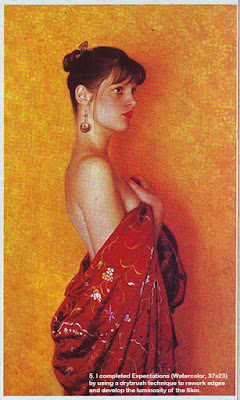 The dry brush technique gives my flesh tones their soft, smooth look. I use small, delicate, transparent strokes of almost pure color to create a rich, vibrant appearance. I’m very particular in my brush choice for this technique: I use a Winsor 86 Newton series 7, round No. 2 sable. Still working transparently and testing my color as I did when applying glazes, I load my brush with color, pat out the moisture with a paper towel, and begin to hatch very delicate lines. Although these lines tend to blend, once you become familiar with this technique, you can control it almost as if you were working with a pencil. Often, I rework areas of the face by applying clean water with a round sable and using a tissue to gently lift color. I then correct the area with glazes and/or drybrush. Similarly, I can also rework edges to be harder or softer.
The dry brush technique gives my flesh tones their soft, smooth look. I use small, delicate, transparent strokes of almost pure color to create a rich, vibrant appearance. I’m very particular in my brush choice for this technique: I use a Winsor 86 Newton series 7, round No. 2 sable. Still working transparently and testing my color as I did when applying glazes, I load my brush with color, pat out the moisture with a paper towel, and begin to hatch very delicate lines. Although these lines tend to blend, once you become familiar with this technique, you can control it almost as if you were working with a pencil. Often, I rework areas of the face by applying clean water with a round sable and using a tissue to gently lift color. I then correct the area with glazes and/or drybrush. Similarly, I can also rework edges to be harder or softer.
With the combination of these techniques, any flaws in my Washes or glazes disappear. I’m Very careful not to overwork my portraits. If you Work layer upon layer areas can become opaque, and you’ll lose that Wonderful transparent glow When I look at the painting and say to myself, “there’s nothing I can do to make it better,” the painting’s complete.
My approach to Watercolor portraits requires patience and Work. But it’s Worth it. By using the three key techniques, you can create luminous flesh tones that both defy the usual look of Watercolor and captivate viewers.
About-The-Artist
 Paul W. McCormack received his art training at the du Cret School of the Arts in Plainfield, New Jersey. He's currently a portrait instructor at that school, as well as two other New Jersey institutions: The New Jersey Center for Visual Arts (Summit) and Somerset Art Association (Bedminster).
Paul W. McCormack received his art training at the du Cret School of the Arts in Plainfield, New Jersey. He's currently a portrait instructor at that school, as well as two other New Jersey institutions: The New Jersey Center for Visual Arts (Summit) and Somerset Art Association (Bedminster).
McCormack is a member of the Hudson Valley Art Association, the New jersey Watercolor Society and Allied Artists of America.
His paintings have won many awards in juried exhibitions.
McCorrnack is represented by Portraits Inc. (New York City) and Swain Galleries (Plainfeld, New Jersey). His work also appears in Splash VI (North Light Books).
About-The-Artist
 Paul W. McCormack received his art training at the du Cret School of the Arts in Plainfield, New Jersey. He's currently a portrait instructor at that school, as well as two other New Jersey institutions: The New Jersey Center for Visual Arts (Summit) and Somerset Art Association (Bedminster).
Paul W. McCormack received his art training at the du Cret School of the Arts in Plainfield, New Jersey. He's currently a portrait instructor at that school, as well as two other New Jersey institutions: The New Jersey Center for Visual Arts (Summit) and Somerset Art Association (Bedminster). McCormack is a member of the Hudson Valley Art Association, the New jersey Watercolor Society and Allied Artists of America.
His paintings have won many awards in juried exhibitions.
McCorrnack is represented by Portraits Inc. (New York City) and Swain Galleries (Plainfeld, New Jersey). His work also appears in Splash VI (North Light Books).

No comments:
Post a Comment
"Thank you for reading my blog, please leave a comment"